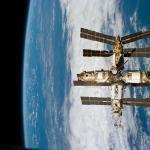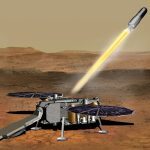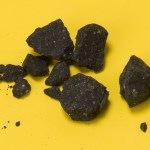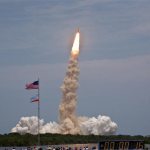Dominique Luchart's Blog, page 626
May 12, 2021
On This Day in Space! May 12, 2000: Last spacewalk at Mir space station, ,

On May 12, 2000, two Russian cosmonauts embarked on the 80th and final spacewalk at the Mir space station. This was also the first commercially financed spacewalk.
A private company called Mircorp paid to launch two cosmonauts, Sergei Zalyotin and Alexander Kalery, on the so-called “MirCorp Mission.” The goal was to reactivate and repair the station after it had been deserted for eight months.
[image error]
The Russian space station Mir as seen from NASA’s space shuttle Endeavour during a Shuttle/Mir mission on Jan. 29, 1998. (Image credit: NASA)MirCorp decided to lease Mir from the government so they could use it for space tourism. The two cosmonauts spent about 5 hours repairing damages and conducting tests outside the station. They also inspected the station’s external hardware to look for signs of wear and tear.
This was all done in preparation for commercial crew missions that never happened, because Russia deorbited the Mir space station the following year.
Catch up on our entire “On This Day In Space” series on YouTube with this playlist.
[image error]
History of NASA: $22.99 at Magazines Direct
Discover the story of how and why NASA was created, its greatest triumphs, darkest days, and of the times it exceeded all possible hopes. A tale of adventure, heroism and resourcefulness, learn of the space agency’s greatest achievements and how — over six decades — the organization has consistently and tirelessly devoted itself to its founding principle: that “activities in space should be devoted to peaceful purposes for the benefit of all humankind”. View Deal
Still not enough space? Don’t forget to check out our Space Image of the Day, and on the weekends our Best Space Photos and Top Space News Stories of the week.
Email Hanneke Weitering at hweitering@space.com or follow her @hannekescience. Follow us @Spacedotcom and on Facebook.
Join our Space Forums to keep talking space on the latest missions, night sky and more! And if you have a news tip, correction or comment, let us know at: community@space.com.
The post On This Day in Space! May 12, 2000: Last spacewalk at Mir space station, , appeared first on NEWDAWN Blog.
NASA really wants a Mars sample return mission. Here’s what’s in store., ,

Plans are firming up to bring a sample of Mars back to Earth in 2031.
A joint webinar last month by NASA and Lockheed Martin, which has participated in NASA sample return missions before, l went over the Mars sample return mission and how NASA’s Perseverance rover will support that effort. The hope is that, by bringing some of the Red Planet back to Earth, we can gain more insight into Mars’ potential for life by using high-resolution lab instruments to examine Martian rocks.
The discussion took place just days after the Biden administration announced its intention to allocate discretionary funds to the sample mission, which would involve a series of U.S. and European spacecraft carefully ferrying pieces of Mars back to Earth.
Related: NASA’s Perseverance rover kicks off audacious Mars sample-return project
The first small step of that effort will happen relatively soon on Mars. Perseverance will dump its first cache of materials at the end of its primary mission in 2023, webinar participants said, and mission planners have already mapped out a potential route that will make the most of the watery environment that filled Jezero Crater with potentially life-friendly materials billions of years ago.
“Lakes and rivers and deltas on Earth are great places to preserve ancient life, and so we think this is a great place – if ancient life ever existed on Mars – to be able to find it,” Jennifer Trosper, Mars 2020 deputy project manager at NASA’s Jet Propulsion Laboratory in California, said of Perseverance’s location.
Trosper showed a map filled with colorful lines, plotting potential “traverse routes” for the rover as it moves from its landing area, dodging some sand dunes en route before arriving at a suspected delta. At the delta, it will take samples of the lake bed and then move on to a nearby crater wall, Trosper said.
Then, it will be time for Perseverance to deposit its cache of samples somewhere. “We have 43 sample tubes onboard the rover, and we plan to do an initial cache at the end of our prime mission … of hopefully 15 or 20 samples,” she said. “It’ll probably be near the crater rim or even on the delta, and then we’ll continue on.”
In 2026, if all goes according to plan, a sample retrieval lander will alight near the cache, using terrain-relative navigation. A fetch rover will pick up the samples and put them inside an orbiting sample container, which will then be placed aboard a Mars ascent vehicle to bring the precious package up to Martian orbit, Trosper noted.
The relay race will continue with the Mars ascent vehicle handing off the samples to an Earth-return orbiter, which will then make the several-month trip back to our planet for arrival in 2031. After entering Earth’s atmosphere, the samples — carefully quarantined to avoid any contamination of our planet or the package — will eventually make their way to NASA’s Johnson Space Center in Texas, Trosper said. (Johnson Space Center already contains numerous Apollo moon samples and is well equipped for protecting space stuff.)
[image error]
An artist’s depiction of Jezero Crater long ago, when it was a lake and Mars still boasted liquid water on its surface. (Image credit: NASA/JPL-Caltech)While the Mars sample return mission is the first effort to retrieve a sample from a potentially life-friendly area, other missions have returned samples from other bodies in the solar system. Humans and robots picked up rocks from the moon in the 1960s and 1970s and sent those back to Earth, allowing scientists to hypothesize that the moon was formed from a collision between Earth and a Mars-like object billions of years ago. More recent studies of Apollo samples in the 2010s, using more advanced equipment, revealed traces of water inside samples that were previously thought to be dry.
Spacecraft have also sampled numerous comets and asteroids, and two sample-return missions are happening right now. Scientists are examining samples from Japan’s Hayabusa2 mission, which landed at asteroid Ryugu in December. They’re also eagerly awaiting the return of NASA’s Origins, Spectral Interpretation, Resource Identification, and Security-Regolith Explorer (OSIRIS-REx) capsule that will bear bits of asteroid Bennu in 2023.
But the Mars sample return will be even more ambitious, said David Mitchell, director of the Engineering and Technology Directorate at NASA’s Goddard Space Flight Center in Maryland. “The significance in this program versus past sample-return missions is it requires several different missions to occur over various points in time,” he said.
Past missions such as Stardust, which returned a sample from a comet in 2006, show the potential for Mars samples to be examined in high definition, said University of Washington astronomer Don Brownlee, principal investigator of the comet sample return mission. As with the Apollo samples before it, scientists keep revisiting the results of the Stardust mission as equipment improves, he said. One later find in 2014, for example, revealed interstellar particles in the sample.
Brownlee said Stardust “revolutionized” scientists’ understanding of comets because the mission showed a strange combination of “ice and fire” forming these icy bodies. The rocky materials in the sample were made in the inner solar system at temperatures of perhaps 1,000 to 2,000 degrees Fahrenheit (540 to 1,100 degrees Celsius). Yet the icy materials were made in temperatures as low as “10s of degrees” above absolute zero, the coldest temperature that can exist, he said.
[image error]
An artist’s depiction of NASA’s Stardust spacecraft packed with comet samples and heading toward Earth. (Image credit: NASA/JPL-Caltech)“We believe that most of the rocky materials in comets formed close to the sun,” Brownlee said, noting that over time, the materials were ejected to the Kuiper Belt, the region just outside the orbit of Neptune and including Pluto’s orbit where most solar system comets come from. Even more notable, most of the rocky material includes biosignatures or biological processes that are indicative of life, he said.
These findings wouldn’t have been possible in space because of the power and mass requirements of the instruments, Brownlee said. “I mean, the biggest instruments used to analyze the return samples were synchrotrons, which can be as big as a shopping center,” he said.
While Mars sample return is high on NASA’s wish list, the agency does plan to send astronauts to the moon to collect samples. again This time, it will be as part of the Artemis program, which may set humans on the moon as soon as 2024, depending on whether the Biden administration carries through the deadline set by the previous administration.
When Artemis goes forward, a “close second” to Mars on NASA Chief Scientist Jim Green’s wish list would be to see humans or helpful robots picking up a core sample from permanently shadowed craters on the moon, where volatiles such as water ice collected over 4.5 billion years from the start of the solar system.
“This will be an incredibly exciting set of material that will, I think, tell us a lot about the origin and evolution of the Earth-moon system,” Green said during the webinar.
Follow Elizabeth Howell on Twitter @howellspace. Follow us on Twitter @Spacedotcom and on Facebook.
The post NASA really wants a Mars sample return mission. Here’s what’s in store., , appeared first on NEWDAWN Blog.
Scientists find liquid water inside a meteorite, revealing clues about the early solar system, ,

[image error]
Fragments of the Sutter’s Mill meteorite, collected by NASA Ames and SETI Institute meteor astronomer Dr. Peter Jenniskens in the evening of Tuesday April 24, 2012 two days after the fall. In a 2021 study, researchers have detected liquid water in minerals in fragments of this meteorite. (Image credit: NASA/Eric James)Scientists have spotted water in a primitive meteorite, expanding our understanding of the ancient solar system.
Water is abundant in our solar system — from the icy rings of Saturn to the subsurface water on its moon Enceladus and the liquid water and ice detected on Mars, water is known to exist beyond Earth. However, while scientists have suspected that water is preserved in a type of meteorite known as carbonaceous chondrites, they have never discovered liquid water in these rocks — until now.
In a new study, researchers detected small pockets of carbon dioxide-rich liquid water in a meteorite hailing from the early solar system. This new work is expanding our understanding of how planets evolved in our solar system as this type of meteorite water could have contributed to water on planet Earth long ago.
The discovery of water in this space rock “gives the direct evidence of dynamic evolution of the solar system,” study author Akira Tsuchiyama, a visiting research professor at Ritsumeikan University in Japan, told Space.com in an email.
Related: Meteorite from brilliant UK fireball is England’s first in 30 years
[image error]
In a new study, researchers have detected liquid water in fragments of the Sutter’s Mill meteorite. (Image credit: Tsuchiyama et al. (2021), Science Advances)Tsuchiyama and their colleagues took a close look at fragments from the Sutter’s Mill meteorite, which formed 4.6 billion years ago and fell to Earth in 2012, landing in the United States. Many pieces of the meteorite were recovered near the Sutter’s Mill gold rush site near Sacramento, California.
They used microscopy techniques to look at the fragments and noticed a tiny calcite crystal harboring an even smaller (think nanoscale) liquid containing at least 15% carbon dioxide. This finding confirmed that both liquid water and also carbon dioxide can exist in ancient space rocks.
“This achievement shows that our team could detect a tiny fluid trapped in a mineral 4.6 billion years ago,” Tsuchiyama said in a statement.
The researchers think that the parent asteroid of this smaller space rock likely formed with frozen water and carbon dioxide, meaning it had to have formed in a cold part of the solar system (most likely beyond Jupiter’s orbit), only later making its way to Earth. This lines up with some previous theories that have suggested that asteroids rich in molecules like water formed far out in the solar system before traveling closer to the sun, according to the statement.
The researchers also think that their findings could help to inform the search for the origins of Earth’s water.
There are many theories about where and how Earth got its water. One of the leading theories suggests that water fell to Earth, trapped inside objects like meteorites (specifically, carbonaceous chondrites). According to this theory, water molecules incorporated in the crystal structures of minerals in these space rocks could be a source of Earth’s water, Tsuchiyama explained.
Now, while “the amount of liquid water found in the present study is very small,” Tsuchiyama said, the study “gives the evidence for the presence of such liquid water.”
“In other words,” they added,” if the water in those minerals contributed to Earth’s water, then it can be considered the “parent” of Earth’s water, and the meteorites hosting these minerals, therefore, the “grandparent material of Earth’s water.”
This work was described in a study published April 21 in the journal Science Advances.
Email Chelsea Gohd at cgohd@space.com or follow her on Twitter @chelsea_gohd. Follow us on Twitter @Spacedotcom and on Facebook.
The post Scientists find liquid water inside a meteorite, revealing clues about the early solar system, , appeared first on NEWDAWN Blog.
VW will start testing its Argo AI-powered self-driving vans in Germany this summer, Andrew J. Hawkins

 Image: VW
Image: VWVolkswagen will start testing its new autonomous vehicles in Germany this summer, the company announced Wednesday. The German automaker’s electric ID Buzz vans will use hardware and software developed by Argo AI, a Pittsburgh-based startup that is backed by Ford and VW. The aim is to launch a commercial delivery and micro-transit service in Germany by 2025.
Executives from VW and Argo convened a press conference this week to provide an update on their partnership, which was first announced in 2019 as an extension of VW’s “global alliance” with Ford. And while much of what they discussed was already known, it did provide a closer look at the timeline for launching a revenue-generating service using VW’s vehicles and Argo’s autonomous…
The post VW will start testing its Argo AI-powered self-driving vans in Germany this summer, Andrew J. Hawkins appeared first on NEWDAWN Blog.
Amazon’s $300 million tax bill rejected by EU judges, James Vincent

 Illustration by Alex Castro / The Verge
Illustration by Alex Castro / The VergeJudges from the European Union’s second-highest court have rejected a €250 million ($300 million) tax bill lodged against Amazon in 2017 as part the bloc’s ongoing fight against US tech giants.
The case was one of a number spearheaded by Margrethe Vestager, the European Commissioner for Competition, in which sweetheart tax deals given to powerful corporations were framed as a form of illegal state subsidy. The most notable of these was a 2016 case in which Apple was ordered to pay Ireland €13 billion ($14.9 billion) in back taxes. This decision was annulled in 2020 by the same court involved in today’s ruling.
The Amazon case can be traced back to 2006, when the e-commerce giant established a labyrinthine tax structure in Europe that…
The post Amazon’s $300 million tax bill rejected by EU judges, James Vincent appeared first on NEWDAWN Blog.
US backtracks on Xiaomi blacklisting, Sam Byford

 Photo by Sam Byford / The Verge
Photo by Sam Byford / The VergeThe US has agreed not to put Xiaomi on a blacklist blocking investment in the Chinese tech company, undoing a move made in the last week of the Trump administration. Xiaomi sued the US government over the designation, but just filed a joint status report with the Department of Defense saying the two parties “have agreed upon a path forward that would resolve this litigation without the need for contested briefing.”
The DoD had decided to designate Xiaomi as a “Chinese Communist Military Company,” which could have forced any American investors to divest their holdings in Xiaomi by November this year. After Xiaomi sued the government in response, a district judge issued a preliminary injunction to block the blacklisting, calling it…
The post US backtracks on Xiaomi blacklisting, Sam Byford appeared first on NEWDAWN Blog.
May 11, 2021
Amazon is suing to stop SMS raffle scams, Sean Hollister

 Photo by Natt Garun / The Verge
Photo by Natt Garun / The VergeEver get a text message informing you that you’ve won a prize — from Amazon itself? I certainly have, and I’ve even known a person or two who fell for those scams. Now, Amazon is attempting to hunt those scammers down, with a new lawsuit aimed at unmasking 50 unknown defendants in federal court.
Here’s the text message I received the other day from one such scammer:
And here’s where it took me when I clicked:
Screenshot: Sean Hollister / The VergeAccording to Amazon’s legal complaint, which you can read in full below, the scam uses Amazon’s logos, web design, and meaningless “surveys” to trick people into buying products (ones that aren’t actually from Amazon), seemingly for cheap. The scammers aren’t…
The post Amazon is suing to stop SMS raffle scams, Sean Hollister appeared first on NEWDAWN Blog.
It seems the patent office wanted number 11 million to be special, not soy, Mitchell Clark

 Photo by SILVIO AVILA/AFP via Getty Images
Photo by SILVIO AVILA/AFP via Getty ImagesThe US Patent Office issued utility patent number 11 million today, granting the milestone number to a patent entitled “repositioning wires and methods for repositioning prosthetic heart valve devices within a heart chamber and related systems, devices and methods.”
Even without understanding exactly what that means, it just screams progress, doesn’t it? Prosthetic heart valves? Surgery? This truly is the future that the patent system enables.
There have, however, been accusations that the patent office cherry-picked which invention would get the most notable number in years (patent 10 million was awarded back in 2018), aiming to give it to something exciting, rather than bland like, say, a soybean.
As a side note, patent numbers are…
The post It seems the patent office wanted number 11 million to be special, not soy, Mitchell Clark appeared first on NEWDAWN Blog.
Bungie accidentally turns on Destiny 2 crossplay months early, Sam Byford

 Image: Bungie
Image: BungieSome Destiny 2 players have been able to play with people on other platforms after developer Bungie inadvertently switched the feature on. Bungie previously said that crossplay would be coming in fall 2021 for every platform that the game is available on, including PC, PS4/5, Xbox One, Xbox Series X/S, and Google Stadia.
The Verge’s Tom Warren spotted that the crossplay feature went live and was able to load up a game with players on both PC and Stadia.
I can confirm Destiny 2 crossplay has been enabled. This is a crucible game between Google Stadia and PC players pic.twitter.com/muspTba7Aw
— Tom Warren (@tomwarren) May 12, 2021
Bungie community manager Cozmo, however, confirmed that crossplay was not supposed to have launched yet….
The post Bungie accidentally turns on Destiny 2 crossplay months early, Sam Byford appeared first on NEWDAWN Blog.
On This Day in Space! May 11, 2009: Final Hubble servicing mission launches, ,

On May 11, 2009, the space shuttle Atlantis launched on the fifth and final servicing mission for the Hubble Space Telescope.
During mission STS-125, astronauts installed two new instruments on the telescope. One was the Cosmic Origins Spectrograph, which allowed Hubble to observe faint objects in the cosmos in ultraviolet light. This would help researchers study the formation of galaxies and other large-scale structures in the universe.
Photos: NASA’s Last Mission to the Hubble Space Telescope
[image error]
A crash landing by the M2-F2 on the Rogers dry lakebed. (Image credit: NASA/Fletcher Hildreth)The second instrument was the Wide Field Camera 3, which replaced the old Wide Field and Planetary Camera 2 that was installed during the first servicing mission in 1993. This new camera could observe the universe in visible, near-infrared and near-ultraviolet light with a higher resolution and larger field of view than any of Hubble’s older instruments.
The crew completed their tasks in five spacewalks over the course of the 13-day mission.
Catch up on our entire “On This Day In Space” series on YouTube with this playlist.
[image error]
History of NASA: $22.99 at Magazines Direct
Discover the story of how and why NASA was created, its greatest triumphs, darkest days, and of the times it exceeded all possible hopes. A tale of adventure, heroism and resourcefulness, learn of the space agency’s greatest achievements and how — over six decades — the organization has consistently and tirelessly devoted itself to its founding principle: that “activities in space should be devoted to peaceful purposes for the benefit of all humankind”. View Deal
Still not enough space? Don’t forget to check out our Space Image of the Day, and on the weekends our Best Space Photos and Top Space News Stories of the week.
Email Hanneke Weitering at hweitering@space.com or follow her @hannekescience. Follow us @Spacedotcom and on Facebook.
Join our Space Forums to keep talking space on the latest missions, night sky and more! And if you have a news tip, correction or comment, let us know at: community@space.com.
The post On This Day in Space! May 11, 2009: Final Hubble servicing mission launches, , appeared first on NEWDAWN Blog.



